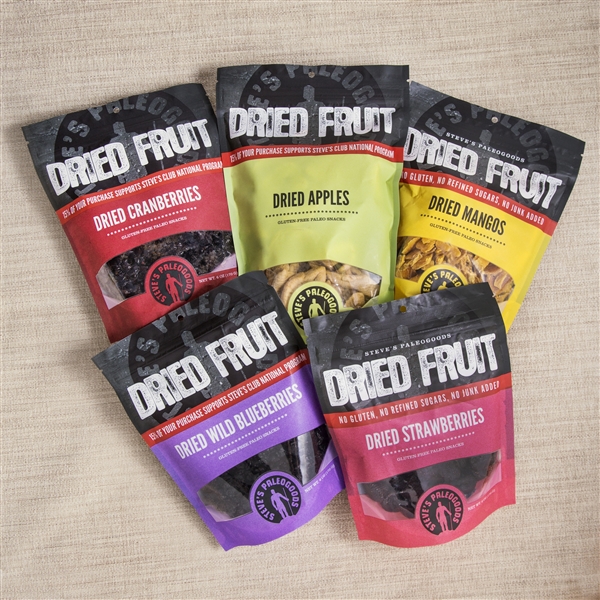Dried fruit is made by dehydrating regular fruit so that it is more easily preserved at room temperature. While unprocessed fruit spoils in a matter of days, dried fruit can last for several weeks or longer when stored at room temperature.
It’s an excellent healthy alternative to heavily processed snack foods like chips and pretzels, which are high in refined carbohydrates and are almost devoid of nutrients.
However, you do need to be careful with dried fruits, because some brands include a lot of added sugar which can harm the health benefits associated with dried fruits as a snack food.
Looking for an easy and healthy snack? We’ve ranked the ten best dried fruits to satiate your hunger and improve your health.
Research
Rankings
1. Mavuno Harvest Dried Fruit
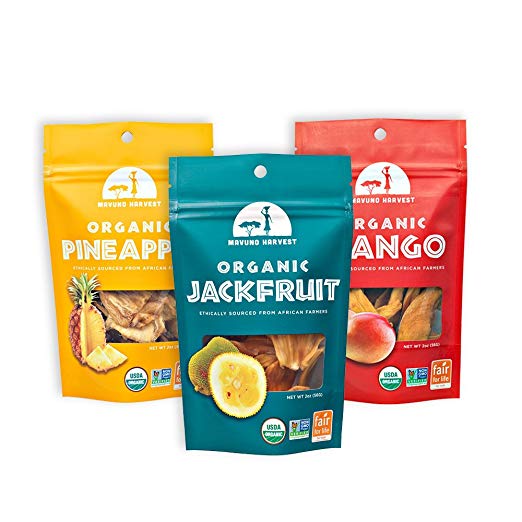
Mavuno Harvest Dried Fruit provides an unique combination of jackfruit, pineapple, and mango in this variety pack.
It’s a good choice if you are looking for something a bit out of the ordinary, and as an added bonus, all of the ingredients are certified organic and there are no added preservatives or added sugar, making it a great choice for health-conscious consumers.
2. Crispy Green Freeze-Dried Fruit
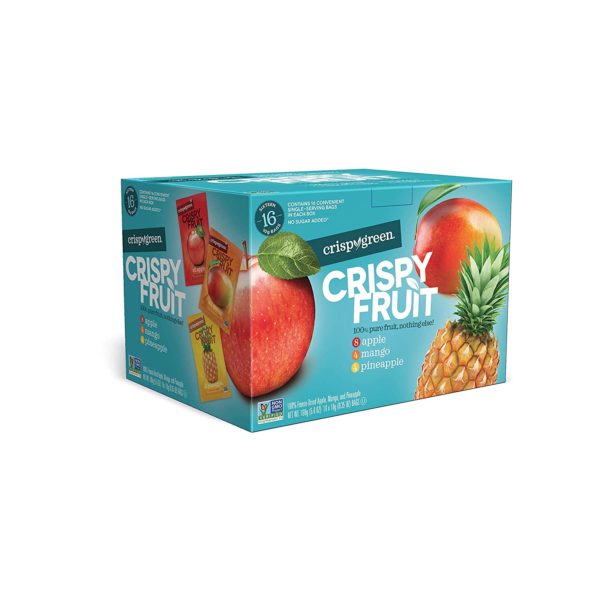
Crispy Green Freeze-Dried Fruit uses a freeze drying process to make dried fruit that has a distinctive dry and almost chip-like texture.
As such, it’s great for snacking, and for a change of pace from the usual taste and texture of dried fruit. Try the variety pack for freeze-dried apples, pears, and tangerines.
3. Its Delish Dried Fruit
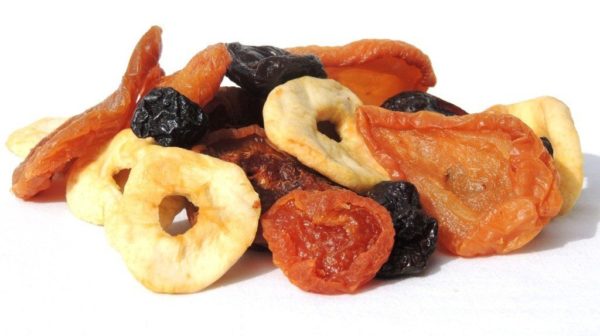
If you go through a lot of dried fruit on a regular basis, Its Delish Dried Fruit is your best option.
This blend includes apple, prunes, pears, and plums, and moreover, contains no added sugar whatsoever. It’s a fantastic choice for high-quality dried fruit that’s got no added sweeteners.
4. RIND Dried Fruit
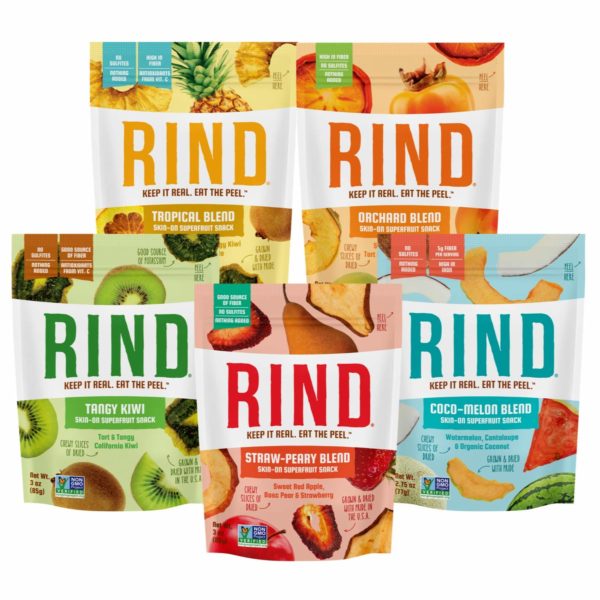
If you want more variety in your dried fruit, RIND is the way to go. These eclectic blends will make sure your taste buds never get tired of the same fruit day after day.
On top of that, they have no added sugar, which makes these a great health-conscious option for snacking on the go.
4. Sunrise Fresh Dried Cherries
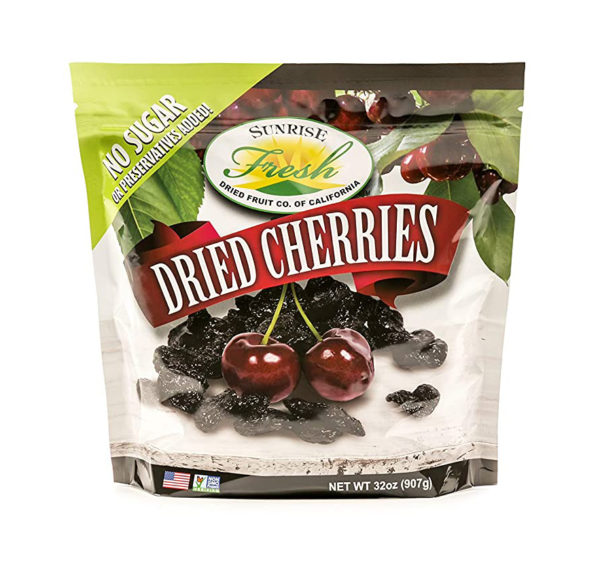
If you want to harness the supreme antioxidant powers of cherries, Sunrise Fresh Dried Cherries are a great choice. These dried fruits have no added sugar, unlike many of the other berry-based dried fruits on the market, and cherries have some of the highest concentrations of antioxidants out there.
While it’s not one for variety, Sunrise Fresh Dried Cherries are still a very solid pick.
5. Mariani Sun-Ripened Mixed Fruit
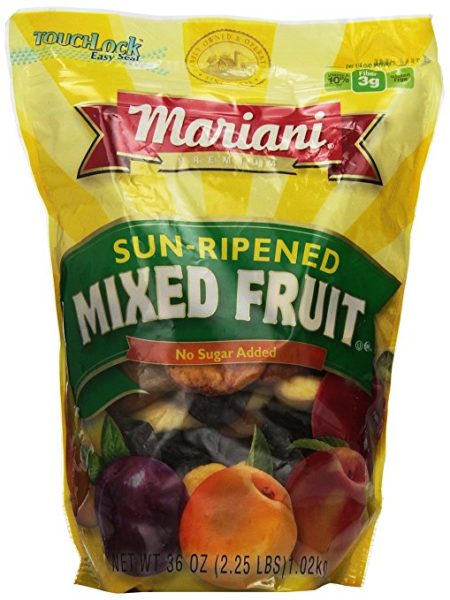
Mariani Sun-Ripened Mixed Fruit contains a robust variety of fruit, from prunes and apricots to peaches, pears, and apples.
This is a great choice for dried fruit if you want more variety in ingredients than some other competitors offer. The only drawback for some people will be the use of sulfites as a preservative for some of the fruits included in this product.
6. Sunny Fruit Organic Dried Fruit
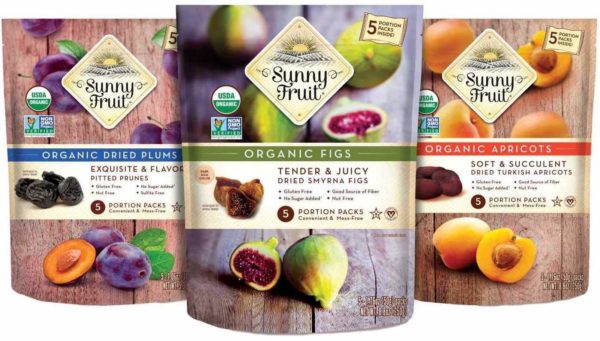
Sunny Fruit Dried Fruit offers some of the best variety when it comes to dried fruit.
Moreover, these dried fruit packs don’t include any added sugar (though the others do, so be aware of that if you are trying to cut out added sugar from your diet).
7. Steve’s PaleoGoods Dried Fruit
Steve’s PaleoGoods Dried Fruit has a variety pack that includes dried apples, mangos, strawberries, blueberries, and cranberries.
The antioxidant power is great, and the purity is pretty good. While there isn’t any cane sugar added, some of the dried berries also included apple juice concentrate, which contains a good bit of sugar.
It’s a solid choice for variety, though if you want to avoid all added sugars, look elsewhere.
8. Anna and Sarah Mini fruit Trail Mix

Anna and Sarah Mini fruit Trail Mix contains diced and dried apples, raisins, pineapple, dates, papaya, and cranberry, which makes it a good source of variety and an easy snack for hiking and camping.
The main drawback is the use of artificial coloring agents and added sugar to augment the appearance and taste of the dried fruits, so if you are looking for an all-natural option, you’ll want to look elsewhere.
9. Gerbs Super 5 Fruit Mix

Gerbs Super 5 Fruit Mix contains a blend of cranberries, raisins, goji berries, and cherries, all of which are well-studied superfoods thanks to their strong antioxidant powers.
However, the benefits of these ingredients might be offset by the high amount of added sugar used to make Gerbs Super 5: each serving has 11 grams of added sugars.
10. Traina Baker’s Fruit Medley
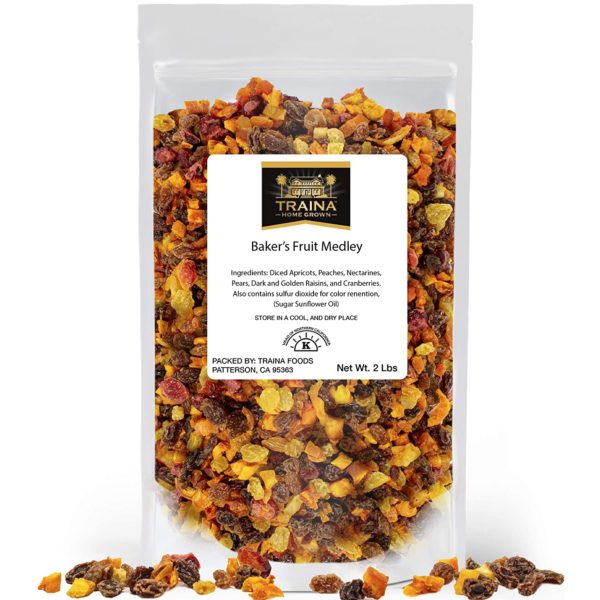
Traina Baker’s Fruit Medley features diced peaches, apricots, cranberries, pears, nectarines, and raisins.
On the other hand, people conscious of artificial ingredients will note that it contains sulfur dioxide for colour retention and sugar sunflower oil, making it less suitable as a health food.
Category winners
Best dried fruit overall: Mavuno Harvest Dried Fruit
Manuvo Harvest makes all-natural dried fruit with no added sugar. Instead of the same old apples and bananas, you get pineapple, mango, and jackfruit—thanks to this variety, Mavuno Harvest takes our top overall spot.
Best dried fruit for snacking: RIND Dried Fruit
RIND is our favorite for snacking thanks to its unmatched variety of flavors: with combos like straw-peary, coco-melon, and orchard blend, you’ll never get tired of eating the same fruit day after day.
Best organic dried fruit: Sunny Fruit Organic Dried Fruit
Sunny Fruit’s figs, apricots, plums, and dates are all organically-grown, meaning you don’t have to compromise on quality or purity when searching for a healthy snack.
Best dried fruit without added sugar: Mavuno Harvest Dried Fruit
We love Mavuno Harvest’s simple and sugar-free approach to dried fruit. You get no unnecessary sweeteners or additives, just natural fruit. Best of all, their dried jackfruit is naturally very low in even naturally-occuring sugar.
Best dried fruit for kids: Crispy Green Freeze-Dried Fruit
Kids are notoriously picky eaters, but they’ll love these bite-sized freeze-dried apple, mango, and pineapple slices. Add to that the fact that they’re free of preservatives and added sugar and you’ve got a real winner.
Best blended dried fruit: Its Delish Dried Fruit
Its Delish makes a simple, no-nonsense dried fruit blend that combines apples, pears, mangoes, and prunes into a bulk-sized mix that’s great for portioning out into snacks or for serving at a party or on a camping trip.
Who should buy dried fruit?
Dried fruit is safe for most individuals and is an excellent alternative to unhealthy snacks. Dried fruit can be an issue for people looking to lose weight since it is very easy to overeat.
Furthermore, diabetics may have an issue with dried fruit due to its effects on blood sugar. Children should consume dried fruit in minimal amounts due to the high sugar content.
How we ranked
Purity was an essential factor when creating our rankings for dried fruit since some brands contain as little as 50% dried fruit. We preferred companies like Crispy Green and Sunrise that was nearly 100% fruit with no added sugar.
We did not include the very popular Fresh Life Sweetened Cranberries, which contained nearly 30% sugar and just a measly 70% fruit.
Preservatives were another issue to consider. Sulfites are often added to fruit to prevent spoilage. However, we omitted most sulfite containing products, except for Mariani, because sulfites can cause issues in certain individuals.
Potassium sorbate is found in a variety of brands and is generally safe for most people. Oil is another preservative that can be added to fruit, and since it’s relatively harmless, it didn’t affect our rankings. Overall, we preferred products like Mavuno Harvest that was organic, preservative-free, and 100% fruit.
Regarding the type of fruit, there was no major advantage. Larger fruits that were less sugary and contained more fiber like apples were preferred only if every other criteria was met above.
Benefits
Dried fruit is a super-concentrated version of fruit. Dried fruit has had all the water removed, so it’s basically a concentration version of the nutrients present in fresh fruit; some hold the opinion dried fruit is healthy, and others say it’s similar to eating candy.
Since most fruits are high in water content, the drying process shrinks fruit down so it ends up extremely energy-dense for its size.
By far the most commonly consumed dried fruit is raisins; other popular choices are prunes, apricots, dates and figs. Some fruits are dried with sugar and labeled as “candied,” such as cranberries, bananas, apples, mangos and pineapples.
Dried fruit keeps for a much longer time than fresh fruit. This makes dried fruit an excellent portable snack for situations where no refrigeration is available.
Dried fruit is nutrient-dense. Since water is the only thing missing from dried fruit, it carries more than three times as many nutrients for its size than fresh fruit.
For example, the folate content of a single serving of dried fruit provides a hefty percentage of the RDI. (1)
Exceptions include vitamin C content, because some is lost in the drying process. (2) But the fiber is still intact, as well as the polyphenols, which are potent antioxidants that bring a range of health benefits. (3)
Polyphenols have been associated with lower levels of oxidative damage in the body, and may improve digestion and circulation; eating foods high in polyphenol antioxidants decreases the risk of developing chronic diseases. (4)
Dried Fruit might help decrease your body weight. Observational studies indicate people who regularly eat dried fruit have lower body weights than those who don’t, as well as ingesting a greater amount of nutrients. (5, 6)
Since these weren’t controlled trials, it’s not possible to be certain participants were lighter or healthier because of the dried fruit they ate, but it does provide good evidence that dried fruit could be an integral part of a healthy lifestyle that can promote weight loss and prevent weight gain.
Raisins are the most popular dried fruit; they are fiber-rich and a good source of potassium, and also deliver other plant compounds known to benefit health. Since the glycemic index of raisins is in the low to moderate range, they are not likely to cause blood sugar spikes after a meal. (7)
People who eat raisins regularly may experience higher satiation levels with meals, potentially resulting in fewer calories consumed. Other benefits include: (8, 9) lower inflammatory markers, decreased cholesterol readings, improvements in blood sugar control and lower blood pressure.
Since these markers are associated with heart disease and type 2 diabetes, eating raisins could drop the risk of developing these disorders.
Prunes are another dried fruit with notable positive effects on health. Made from plums, prunes are well-known for their laxative effect, and are rich sources of fiber, vitamins A and K, and potassium.
The reason prunes get things moving along inside is more than the fiber content; they are also one of the fruits containing sorbitol, a sugar alcohol, which can stimulate digestion.
A popular remedy for constipation, prunes have been found to improve both consistency and frequency of stools. (10)
Loaded with antioxidants, prunes can also inhibit oxidization of LDL cholesterol in the blood, which may lower the risk of developing cancer and heart disease. (11, 12)
Prunes are also a good source of boron, a mineral shown to be helpful in fighting osteoporosis. (13)
Dates are extremely sweet, but the glycemic rating is low, so blood sugar spikes aren’t an issue. (14) Dates provide a higher level of antioxidants than most other fruits, along with fiber, iron and potassium.
One area of extensive testing is the way dates affect women’s health in relation to pregnancy and labor.
Studies indicate women who eat dates during the last trimester of pregnancy are more likely to experience smooth and efficient dilation. (15)
In one study, only 4% of women eating dates over the last weeks of pregnancy needed to have labor induced, while 21% of those who didn’t eat dates required induction. (16)
Side effects
The primary negative effects of dried fruits usually have to do with their fairly high carb content and, in many cases, substantial amounts of added sugar.
Fruits are loaded with natural sugars, and when they’re dried, the sweetness is concentrated into a much smaller package, so it may be easier to ingest more sugar than intended when snacking.
The glucose and sucrose contents of dried fruits tend to run high, which means calorie counts can be significant.
For example, you’ll get 84 calories from a one-ounce serving of raisins, with virtually all calories coming from sugar.
Some popular dried fruits have quite high sugar content (17). For example, dates and raisins can have sugar contents of 59-66%, while apricots and figs clock in near 50%. Prunes are lower in sugar, at 38%.
Between 22% and 51% of the sugar in fruits comes from fructose. Eating large amounts of fructose has been shown to have negative effects on health, including weight gain and higher risks for developing heart disease and type 2 diabetes. (18)
Read ingredient labels to make sure you don’t buy candied fruit, which has had sugar or syrup added before the drying process. This ups the calorie count even more, and while it’s gauged to increase appeal, it’s certainly overkill, since dried fruit is already quite sweet.
Added sugar in the diet has been fingered as one of the most destructive aspects of the modern diet. Not only does it jack up the risk of obesity, but it increases the chance of developing cancer and heart disease. (19, 20)
Sulfites are often added to dried fruit because they prevent discoloration through acting as a preservative. This is a common strategy for the more brightly colored fruits like apricots or raisins.
People with sulfite sensitivities can experience skin rashes, stomach cramps or asthma attacks after ingesting foods laced with sulfites. (21) Choose fruits that are less colorful, even gray or brownish, to avoid sulfites.
When dried fruit isn’t properly stored, toxic contaminants like fungi can be present, so be cautious about sources. (22)
FAQ
Do dried fruits contain protein? Dried fruits are not typically recognized for their high protein levels. Protein is more commonly found in meat, dairy products, and nuts, and the protein values in fruit are often insignificant. However, there are trace amounts of protein in nearly everything, and dried fruits are no different. On average, dried fruit has less than one gram of protein per serving, which obviously results in a higher protein intake when consumed in more copious amounts. Very few fruits demonstrate levels higher than two grams per serving.
Which dried fruits have the most protein? The dried fruits highest in protein content include apples (2 grams), figs (5 grams), and prunes (5 grams). It is essential to consider the fact that the dried fruits highest in protein are also relatively high-calorie foods. So, while you may be consuming five grams of protein in one serving of dried fruit, you may also be consuming about 300 calories.
Does dried fruit have more sugar than fresh fruit? Dried fruit has almost the exact same effects on the body as fresh fruit. One of the significant differences between the two types of fruit is the fact that dried fruits often have added sugar when sold in stores. This is in addition to the sugar naturally found in fruits, making dried fruits more sugary than fresh fruit.
Is the nutritional value of dried fruit and fresh fruit different? The nutritional value of dried fruit and fresh fruit are relatively similar. The most considerable difference between dried fruit and fresh fruit is the physical size of each serving. When the moisture is removed during the drying process, the fruit itself becomes much smaller while maintaining the same nutritional value.
Is dried fruit a laxative? Dried fruit can produce a laxative effect, given its significant fiber content. In particular, dried fruits like apples, bananas, and strawberries have about 4 grams of fiber per serving. When dried, these fruits are much smaller in size, and it is easier to consume more of these dried fruits in one sitting. Therefore, there is a higher chance that you will eat more dried fruits, consume higher levels of fiber, and thus experience the effects of fiber. An increase in fiber can result in diarrhea and improved gastrointestinal functioning, similar to a laxative effect. The best way to prevent this is to stick to the recommended serving sizes.
Does dried fruit raise blood sugar? The glycemic index of dried fruit depends on the type of fruit. The glycemic index of these fruits often ranges from about 20 to over 60, which the higher value approaching a “high” glycemic index level. The nutritional content of fruit contains a significant amount of sugar, which ultimately raises blood sugar levels. If you are diabetic or looking to control your blood sugar levels, dried fruit, like natural fruit, should be consumed in moderation.
Should you wash dried fruit? Unless specified on the packaging, you should always wash dried fruit before eating. Like natural fruits and vegetables, there is a possibility that dried fruits will include dirt or other unsavory debris on their exterior. Washing dried fruit ultimately cleans the fruit and reduces the risk of consuming bacteria or dirt found on the fruit.
How is dried fruit made? Dried fruit is typically made in one of two ways. If being dried naturally, you can place sliced fruit out in the sun to remove the moisture within the fruit and create the “dried” effect in the fruit. This process can take several days, and the effectiveness varies based on the type of fruit, the power of the sun’s rays, and the humidity. When using a dehydrator to make dried fruit, the process can last about six hours. The sliced fruit is placed in the dehydrator at a temperature of about 113 degrees until the fruit is entirely dried, with the time required to dry the fruit varying based on the fruit itself entirely. If making dried fruit at home, your oven can be used to mimic a dehydrator to dry the fruit.
What are the health benefits of dried fruit? Like regular fruit, dried fruits also provide consumers with an optimal level of nutrients. What sets dried fruit apart from regular fruit is the density of nutrients, as dried fruits contain about the same level of nutrients as regular fruits, but in smaller sizes. Dried fruit is also known for its high level of antioxidants as well as fiber. As a result, there is an improvement in gastrointestinal health and a potentially lower risk of developing some types of cancer. One study showed that consuming dried fruits improves overall nutrition. Specifically, these participants had a lower intake of sugar and fats than those not consuming dried fruit. Those who consumed dried fruit also had a lower weight, body mass index (BMI), and waist circumference than those who did not consume dry fruits (23).
With the confirmation that lower intake of vegetables and fruits may lead to an increased risk of cancer development, one study researched the connection between eating dried fruit and cancer risk. The study showed that, when eaten between three and five times per week, the risk of cancer significantly decreased in those eating dried fruits. In particular, this study demonstrates that eating dried fruit can reduce the likelihood of developing cancers affecting the gastrointestinal tract in particular (24).
What fruits can you buy dried? Nearly any fruit can be purchased in its dried form. In particular, the more popular dried fruits include apricots, peaches, prunes, and figs. The most popular dried fruit is undoubtedly raisins, which are dried grapes. Dried fruits can be purchased at your local grocery store, or you can make them yourself at home using your oven.
Why is sugar almost always added to fruit when it is dried? The primary reason that sugar is added to dry fruits is to make them taste better to consumers. The average regular fruit (not dried) can sometimes contain sugar levels of over 20 grams. Though fruit is naturally sweet, adding sugar makes dried fruit even more popular as a snack, specifically for children and those craving sweets. Whether or not this is healthy is up for debate.
Can you make dried fruit at home? Making dried fruit is a relatively straightforward process that results in a nutrient-dense snack. Generally, dried fruit is made by placing fruit directly in the path of the sun or by using a dehydrator machine. To perform this process at home, you will need an oven and a baking sheet to place the fruit on. With the oven set to about 170 degrees, place the baking sheet containing the sliced fruit in the oven. This process takes several hours to get the full effects of dried fruits. Once completed, store the fruit appropriately.
What is the best-dried fruit for weight loss? There are some studies that show a connection between dried fruit and weight loss, but there are no specific dried fruits connected directly to weight loss. In general, dried fruit can be beneficial, but long-term results have yet to be proven. However, the connection between eating dried fruits and lower appetite levels could explain weight loss in consumers. The fruits associated with lower appetite levels are apricots, dates, raisins, prunes, and many more (25).
Which dried fruit is the lowest in sugar? Among the dried fruits highest in sugar are cranberries (72 grams), dates (63 grams), and pears (62 grams). When considering the fact that these are based on 100-gram serving sizes, more than half of the content of dried fruits is sugar. As a point of reference, the American Heart Association recommends the consumption of fewer than 40 grams of sugar per day. Some of these fruits contain sugar values of more than double the recommended limit.
In general, fruits with low-sugar qualities include peaches, apples, strawberries, and apricots. Most of these fruits contain less than 20 grams of sugar per serving. It is important to remember that this is based on a single serving and that given the physically smaller size of dried fruit, it is much easier to consume more than one serving of dried fruit than regular fruit. Large quantities of dried fruit, regardless of the fruit itself, runs the risk of high sugar intake (26).
Why are dried fruits so popular? Dried fruits are becoming more and more popular because they are easier to eat than actual fruit, but also provide the same health benefits that regular fruit does. Unlike regular fruit, dried fruit often has added preservatives used to extend its shelf-life and last longer, which is an ideal characteristic when it comes to snacks.
Additionally, there has been a global interest in foods and beverages that are high in antioxidants. The global obsession of detoxifying the body and helping to prevent the development of chronic diseases has led to increased popularity in foods with these qualities, such as dried fruit.
Is dried fruit all sugar? Dried fruit is not all sugar, but it does have a tremendous amount of sugar for every serving. The primary reason that these snacks are considered high sugar, as compared to natural fresh fruit, is because of the physical size of these snacks. If you take into consideration the size of a regular apricot and compare it to a dried apricot, which is significantly smaller, you are more likely to consume more than one serving (or one whole apricot) in its dried state. There are some dried fruit varieties that include a sugar content of over 50 grams, which can have a dramatic effect on blood sugar levels and overall health.
Why are oils sometimes added to dried fruit? The primary reason that oil is sometimes added to dried fruit is to preserve the fruit for longer. The addition of oil may also assist in preserving the taste and nutrients found in dried fruit. There isn’t a significant concern with the oils added to dried fruits because they are light oils and typically also prevent pests and fungi from destroying the product. If you are looking for an all-natural dried fruit, there are alternatives that do not include added oils, sulfur, or other preservatives.
What is unsulfured dried fruit? Like oil, sulfur dioxide is sometimes added to dried fruit products to aid in the preservation and promote a longer shelf-life. In addition to preservation, sulfur also helps the dried fruit to maintain a more appealing color and appear more appetizing to the average consumer. In large doses, there are some health concerns associated with added sulfur. A majority of the possible health consequences of consuming sulfur dioxide relate to the lungs, eyes, and ability to breathe normally. However, these effects are a result of frequent exposure to larger amounts, and you should be safe consuming dried fruit with sulfur added as a preservative.
Related Articles
Recap
The upside to including dried fruit in your diet is that it’s rich in fiber and important nutrients. The downside is it’s high in sugar and calories, particularly if you get a brand of dried fruit that has added sugar.
Dried fruit is a much healthier snack than chips or other common junk foods, and it can be beneficial as long as you don’t overdo it.
Stick with small amounts, because the sweet taste makes it easy to help yourself to another handful when an ounce or two would have been enough.
For Body Nutrition’s #1 dried fruit recommendation, click here.
